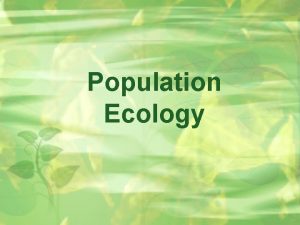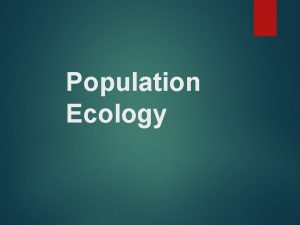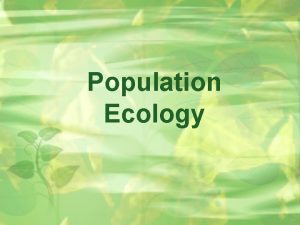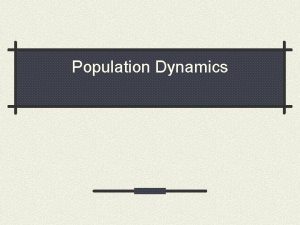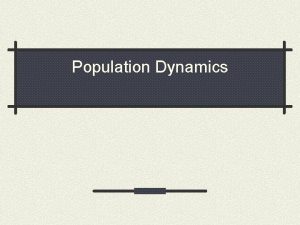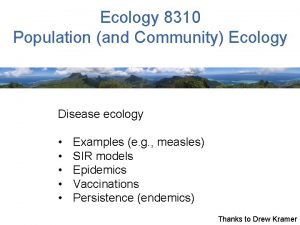Population Ecology Population Population All the individuals of















- Slides: 15

Population Ecology

Population • Population: • All the individuals of a species that live together in an area

Three Key Features of Populations • Growth Rate: • Birth Rate (natality) - Death Rate (mortality) • How many individuals are born vs. how many die • Birth rate (b) − death rate (d) = rate of natural increase (r)

Factors That Affect Future Population Growth Immigration Natality + + Population Emigration - Mortality

How Do Populations Grow? • Idealized models describe two kinds of population growth: 1. Exponential Growth 2. Logistic Growth

Carrying Capacity • Carrying Capacity (k): • The maximum population size that can be supported by the available resources • There can only be as many organisms as the environmental resources can support

Exponential Growth Curve Figure 35. 3 A

Logistic Growth Curve

Factors Limiting Growth Rate • Declining birth rate or increasing death rate are caused by several factors including: • Limited food supply • The buildup of toxic wastes • Increased disease • Predation

“Booms” and “Busts”

Reproductive Strategies • R Strategists § Short life span § Small body size § Reproduce quickly § Have many young § Little parental care § Ex: cockroaches, weeds, bacteria

Reproductive Strategies • K Strategists § Long life span § Large body size § Reproduce slowly § Have few young § Provides parental care § Ex: humans, elephants

Human Population Growth • J curve growth • Grows at a rate of about 80 million yearly • r =1. 3% • Why doesn’t environmental resistance take effect? • Altering their environment • Technological advances • The cultural revolution • The agricultural revolution • The industrial-medical revolution

The Human Population • Doubled three times in the last three centuries • About 6. 1 billion and may reach 9. 3 billion by the year 2050 • Improved health and technology have lowered death rates

History of the Human Population
 Chapter 4 population ecology section 1 population dynamics
Chapter 4 population ecology section 1 population dynamics Section 1 population dynamics answer key
Section 1 population dynamics answer key Population ecology section 1 population dynamics
Population ecology section 1 population dynamics Chapter 4 section 1: population dynamics
Chapter 4 section 1: population dynamics Population ecology example
Population ecology example Define exponential population growth
Define exponential population growth Is india near the equator
Is india near the equator Ecosystem vs community
Ecosystem vs community Concept 3 population ecology
Concept 3 population ecology Chapter 53 population ecology
Chapter 53 population ecology Chapter 36 population ecology
Chapter 36 population ecology Chapter 4 population ecology answer key
Chapter 4 population ecology answer key Survivorship curve def
Survivorship curve def Chapter 53 population ecology
Chapter 53 population ecology Population characteristic
Population characteristic Chapter 4 section 1 population dynamics answer key
Chapter 4 section 1 population dynamics answer key



















